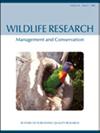Increasing the accuracy and efficiency of wildlife census with unmanned aerial vehicles: a simulation study
IF 1.6
3区 生物学
Q3 ECOLOGY
引用次数: 0
Abstract
ABSTRACT Context. Manned aerial surveys are an expensive endeavour, which is one of the core reasons for insufficient data coverage on wildlife monitoring in many regions. Unmanned aerial vehicles (UAVs) can be a valid, cost-efficient alternative, but the application of UAVs also comes with challenges. Aims. In this explorative simulation study, our aim was to develop an efficient layout of UAV surveys that could potentially overcome challenges related to double counts of individuals and even area coverage, and that would minimise off-effort travel costs. Methods. Based on different simulated survey layouts we developed hypothetically for the Katavi National Park in Tanzania, we quantified the advantages that UAVs might offer. We then compared these findings with manned aerial surveys. Key results. The proposed new survey design and layout indicated an increase in survey efficiency of up to 21% when compared with conventional survey designs using parallel transect lines. Despite the complex flight pattern, the accuracy of the flight paths of the UAV outcompeted those of manned aerial surveys. The adapted survey layout enabled a team of two operators with a small battery-powered UAV to cover an area of up to 1000 km2 per day, without specific infrastructural requirements. Conclusion Our calculations may serve as a vital spark for innovation for future UAV survey designs that may have to deal with large areas and complex topographies while reducing operational effort. Implications. UAV applications, if well designed, provide useful complementation, if not replacement, for manned aerial surveys and other remotely sensed data collections. Our suggested survey design is transferable to other study regions, and may be useful for applying UAVs efficiently.利用无人机提高野生动物普查的准确性和效率:模拟研究
本文章由计算机程序翻译,如有差异,请以英文原文为准。
求助全文
约1分钟内获得全文
求助全文
来源期刊

Wildlife Research
生物-动物学
CiteScore
4.30
自引率
15.80%
发文量
56
审稿时长
3 months
期刊介绍:
Wildlife Research represents an international forum for the publication of research and debate on the ecology, management and conservation of wild animals in natural and modified habitats. The journal combines basic research in wildlife ecology with advances in science-based management practice. Subject areas include: applied ecology; conservation biology; ecosystem management; management of over-abundant, pest and invasive species; global change and wildlife management; diseases and their impacts on wildlife populations; human dimensions of management and conservation; assessing management outcomes; and the implications of wildlife research for policy development. Readers can expect a range of papers covering well-structured field studies, manipulative experiments, and analytical and modelling studies. All articles aim to improve the practice of wildlife management and contribute conceptual advances to our knowledge and understanding of wildlife ecology.
Wildlife Research is a vital resource for wildlife scientists, students and managers, applied ecologists, conservation biologists, environmental consultants and NGOs and government policy advisors.
Wildlife Research is published with the endorsement of the Commonwealth Scientific and Industrial Research Organisation (CSIRO) and the Australian Academy of Science.
 求助内容:
求助内容: 应助结果提醒方式:
应助结果提醒方式:


